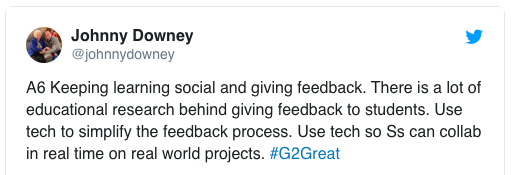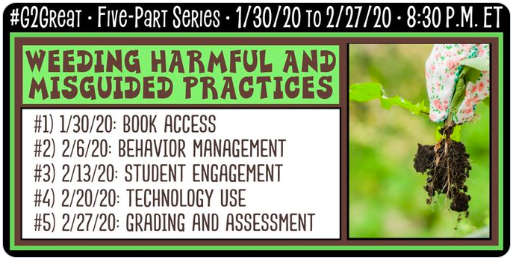“To ensure that technology integration is meaningful this school year, step back and review your curriculum goals for the first quarter. With your curriculum goals in mind, how can you use technology to provide relevance to students, meet their individual needs, and do something that wouldn’t have been possible five or 10 years ago? The use of a Chromebook, interactive whiteboard, or tablet isn’t always the answer. But when you locate a moment in your unit when students can participate in a video conference with an expert, collaborate with a partner classroom on another continent, or build empathy as they watch a video of life in another corner of the world, powerful, integrated learning experiences can happen.”
Monica Burns in Embracing a Tasks Before Apps Mindset (ASCD, 2018)
On Thursday, February 20 #g2great hosted Part 4 of the series Weeding Harmful and Misguided Practices by focusing on technology in the classroom. To view the entire chat, you can access the Wakelet here.
It’s important to give special attention to Monica Burn’s quote above in her ASCD article published in 2018. We often think of technology in the classroom in terms of consumption of information. There must be the shift from consumption primarily to creation of content.

Consumption of content is empowering indeed and can yield impetus to transform. Could we instead change our thinking to include opportunities for creating products that give evidence of student learning? There is value in having access to technology that provides up-to-date information in real time. Technology has the raw potential for more collaborative learning environments. Students are able to work together in powerful ways online. They are able to work together to create products, solve problems and interact with others to find workable solutions.
“…teachers who do develop innovative uses of technology are more commonly in learning environments that serve affluent and advantaged students. Most educators are familiar with the “digital divide” as the gap in access to new technologies found between more and less affluent students, families, or school communities. In the early 2000s, sociologist Paul Attewell (2001) proposed a second digital divide: the usage divide. In his research, Attewell used anthropological observations in schools and classrooms to document the different levels of parent support at home and content rigor in schools. Even when access gaps are closed, white and affluent students are more likely to use technology for creativity and problem solving with greater levels of mentorship from adults, while students from minority groups and low-income neighborhoods use technology more commonly for routine drills with lower levels of adult support.”
Justin Reich in Teaching Our Way to Digital Equity (ASCD, February 2019).

Paul Attewell cautioned in 2001 that: “[There is a] real possibility that computing for already-disadvantaged children may be dominated by games at home and unsupervised drill-and-practice or games at school, while affluent children enjoy educationally richer fare with more adult involvement.” It’s important that the issue of equity was raised in our chat Thursday evening. We must, as educators, constantly reflect on whether our use of technology in facilitating student learning is aligned to educational standards and individual student needs.
“So educators should ensure that technology doesn’t remove the social component to learning; it should instead include opportunities for students to engage in meaningful conversations and reflect with others on what they are working on (Hirsh-Pasek et al., 2015).”
Liz Kolb in Smart Classroom-Tech Integration (ASCD 2019)

Technology must be thought of through the lens of how much value is added to the student learning process. In this learning task, does technology enhance the learning over more traditional resources typically applied? Teachers would be wise to reflect on whether value is added by integrating technology for the specified activity over a more traditional practice. It’s true that the added value could provide a more authentic learning experience. It could also aid and support by providing scaffolds and support to allow students personal success in learning.
This series, Weeding Harmful and Misguided Practices, serves not only to rid our classrooms of less than productive practices, but can also serve to provoke reflection on the most effective tools and application of sound pedagogy.
Join us for the final installment in this series on Thursday evening, February 28.
